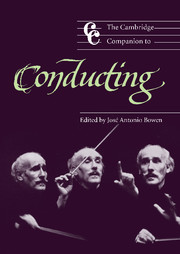11 - The Italian tradition
from Part II - History
Published online by Cambridge University Press: 28 September 2011
Summary
The conductor, in any form recognizable today, emerged later in Italy than in other European countries. Italy had no Habeneck or Berlioz, no Spohr or Mendelssohn – and later, as the role of the professional conductor developed, No Bülow or Richter or Nikisch. It was not until the first years of the twentieth century that a real Italian star exploded on the international scene, and if the blaze of Toscanini's fame has tended to obscure the activities of his predecessors, that is chiefly because they had been obliged to struggle for so long with the last vestiges of a ubiquitous native tradition that would not easily relax its grip.
The dominating feature of that tradition was opera. The Italians invented opera, and they remained faithful to it as their main form of musical expression and social enjoyment for the best part of three centuries; in spite of the jigsaw of political frontiers it spread remorselessly over the whole peninsula, and was accompanied by a parallel decline in other forms of music. Church music (much of it on operatic lines) remained in constant production, but the history of Italian instrumental music, after the great days of the Baroque concerto, is one of gradual attenuation; the few interested Italians tended to go abroad – Boccherini to Spain, Clementi to England, Cherubini and Spontini to Paris. Italy was “the land of song,” and symphonic developments in other parts of Europe were regarded at best as irrelevant to the melodic invention that was the real purpose of music, at worst as a serious threat to it; orchestral complication was viewed with mistrust.
- Type
- Chapter
- Information
- The Cambridge Companion to Conducting , pp. 146 - 162Publisher: Cambridge University PressPrint publication year: 2003
- 1
- Cited by



